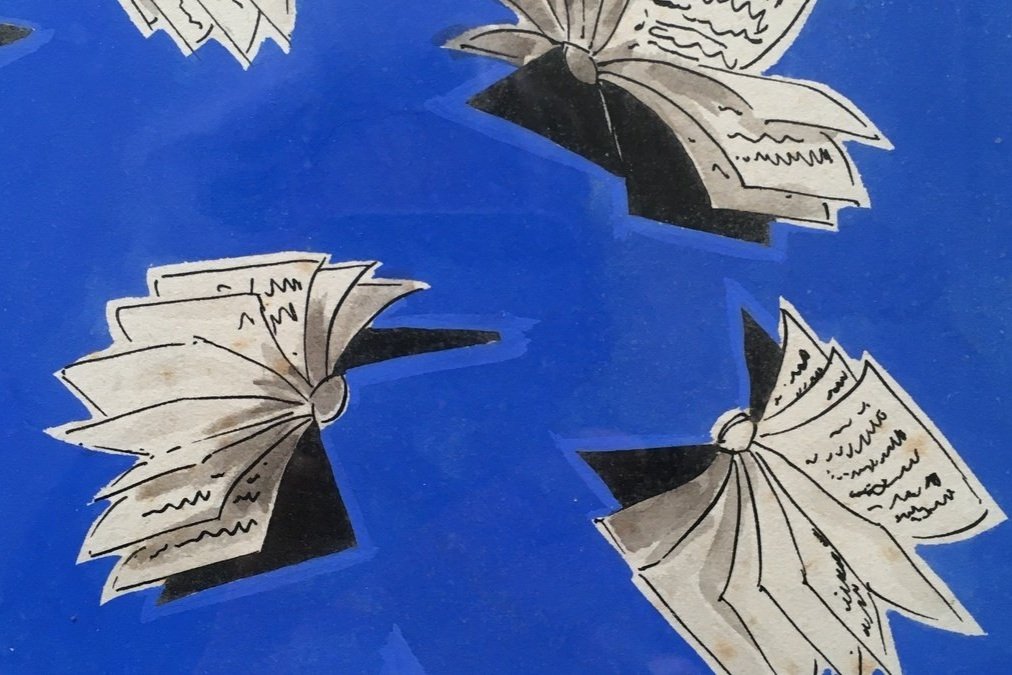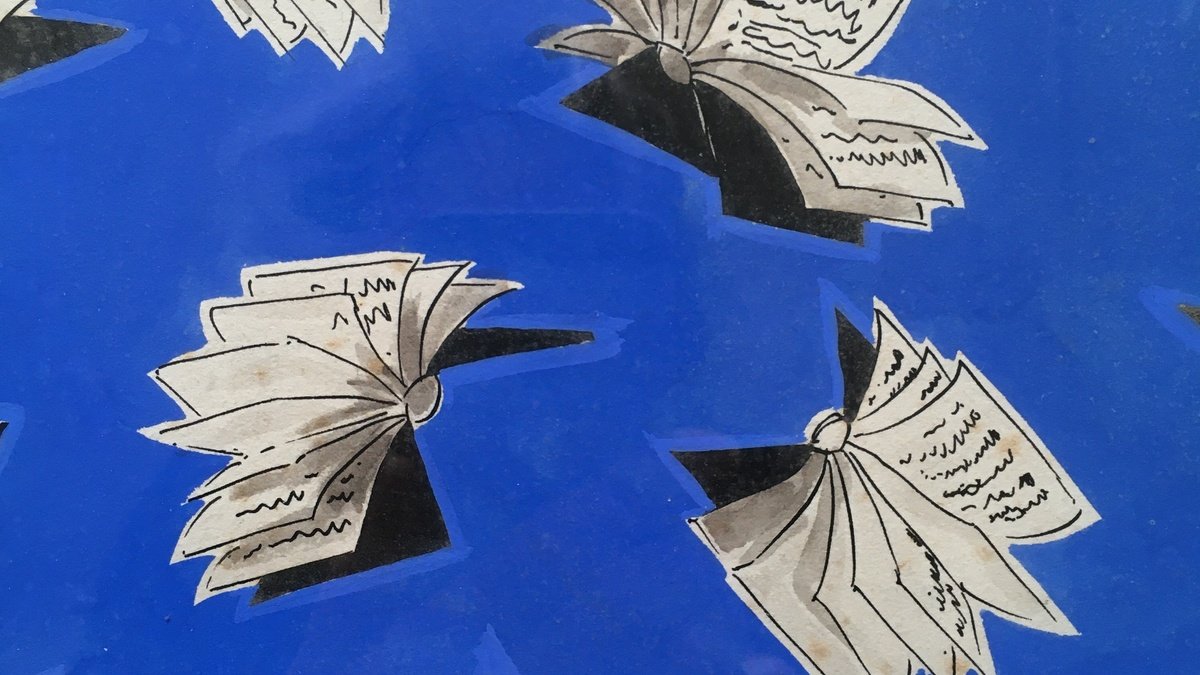Textile Designers in Exile
Frank Designs, Mid-Century Dress Fabric, courtesy of Celia Frank
In this article, Anna Nyburg writes about refugees whose lives were changed by the Second World War and Nazism across Europe.
Two such people were the textile designers Bernat Klein and Tibor Reich. They had much in common in their shared appreciation of a love of colour and texture, which was to change the drab post-war British palette of the 1940s and ‘50s. A passion for modernism was another of Bernat and Tibor's shared traits and influences.
As a consequence of the Second World War, both men found themselves in post-war Britain studying textiles technology at the University of Leeds - Bernat Klein from Serbia by way of his design studies in Jerusalem - and Tibor Reich from Budapest and his design studies in Vienna before the outbreak of the war.
They were amongst some eighty thousand refugees who had escaped to safety in Britain, of whom some ninety percent were Jewish.
The textile history of the Jewish people has long been associated with the rag trade, which originated in Europe of the Middle Ages, when selling second-hand fabrics and clothes was one of the few sanctioned occupations for Jews.
As they traded their wares throughout Europe, Jewish pedlars gained knowledge about both fabrics and customers - what sold well, where to find saleable textiles and clothing - and how much people were willing to spend for these goods.
By the time of their emancipation in Europe, the Jewish people’s in-depth knowledge was essential in the growing textile and clothing industry, with some establishing department stores, ready-to-wear clothing companies and fabric mills.
One area of fashion where Central Europe was ahead of Britain in the 1930s, was in training. The famous Reimann Schule, which itself became a refugee to London re-established as the Reimann School, bringing with it students and staff from Berlin, was a college where fashion design, textile design, photography and window display among other subjects could be studied.
In Vienna design training had been developed by, for example the Kunstgewerbeschule, which was affiliated with the famous Wiener Werkstätte studios.
Thomas Heatherwick with a design by Elizabeth Tomalin, courtesy of Thomas Heatherwick
British design later benefited directly from the large number of refugees with specialist textile training and education.
In the contemporary design world, Thomas Heatherwick, now one of Britain’s most celebrated designers and architects, could be said to still bear the influence of pre-war Germany. His grandmother, Elisabeth Wallach a German Jewish refugee from Dresden, trained in textile design at the Reimann Schule in Berlin, before fleeing to London just before the Second World War.
After the war and her work at the Ministry of Information, Elisabeth Tomalin, now married to an Englishman, was employed by Marks & Spencer to set up the new print department, designing dress fabrics worn by millions of British women. As her grandson acknowledges, Elisabeth Tomalin’s dedication to modernism, was a great influence on Heatherwick's own development.
The influence of European refugees on British textile design and the new aesthetic is due in part to Zika and Lida Ascher. Zika Ascher born into a textile family of Czech Jews, ran a shop with his brother in Prague, which as well as selling the latest designs in fabrics, also featured state-of-the-art moving window displays.
Zika Ascher was a talented skier who represented Czechoslovakia in European skiing events. After marrying in 1939, Lida and Zika Ascher set off for Norway, ostensibly on a skiing honeymoon, but in fact fleeing for Britain from the German occupation of Czechoslovakia.
During the war in which Zika had joined the Czech army, Lida, who had no design experience, created new fabric designs later bought by the Anglo-Irish couturier Edward Molyneux, who became a great supporter of the Aschers, and indeed other refugee textile designers.
Edward Molyneux – Drawings by Eva Aldbrook
As a creative couple the Aschers were innovative and continually developed imaginative and new ideas in textile design.
In the late 1940s their high profile collaboration with well-known artists, including Picasso and Matisse, produced a collection of much sought after silk head-scarves.
The Aschers also quickly adapted to new opportunities and moved into the 1960s with new ideas and designs. So contributing to an innovative period of British textile design.
Other less high profile, but equally successful textile companies, included the prolific and popular designer Julius Frank of Frank Designs, who in 1936 had fled to Britain. Frank established his company in which he employed some twenty-five designers including some fellow refugees in two branches, Hendon and Manchester. Unlike thousands of his countrymen. Julius Frank was not interned as an enemy alien, but was allowed to continue working to support the war-time economy.
Frank Designs, Mid-Century Dress Fabric, courtesy of Celia Frank
Although Frank chose a more simple timeless Scandinavian aesthetic for his family’s clothes, his designs were varied and featured both geometrical and naturalistic patterns.
While this small number of successful textile designers and producers, whose Jewish heritage had forced their migration to Britain is highlighted here, there remain many untold stories of those who never practised their trade again. However, those who found safety in Britain more than repaid their debt by bringing employment and income to their host nation. The tremendous contribution made in this particular period of immigration to Britain, has become part of the narrative of British textiles that is so celebrated and enjoyed today.
Anna Nyburg is an Honorary Lecturer at Imperial College London. The subject of her PhD dissertation (2009, University of London) in Exile Studies was refugees from Nazism and their transformation of art publishing in Britain. She has published and spoken on this topic, and also on different aspects of refugee designers and their work, in the UK and Europe. She co-produced a film on refugee designers first shown at the V&A Museum, London. She is a committee member of the Research Centre for German and Austrian Exile Studies at the University of London. Her latest book is ’The Clothes on our Backs: How Refugees from Nazism revitalised the British Fashion Trade’ (2020).







